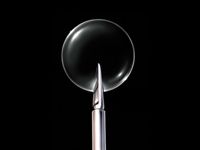Article
IOL cutter small size, strength boons to IOL explantation procedure
A proprietary IOL cutter (Packer/Chang IOL Cutter, Microsurgical Technology) is a micro-scissors that can be inserted through a paracentesis incision while the surgeon holds the optic with a forceps through the phacoemulsification incision. The instrument facilitates safe removal of IOLs.

Key Points

David F. Chang, MD, in private practice in Los Altos, CA, and Mark Packer, MD, in private practice in Eugene, OR, designed the 19-gauge instrument, which can fit through a 1.2-mm incision.


"The size and bulk of many traditional instruments can make it difficult to maintain a deep ophthalmic viscoelastic device (OVD)-filled anterior chamber due to gapping of the incision," he said. "It may be difficult to fixate and immobilize the optic, which can strike the corneal endothelium if it twists and rocks. Finally, the length and size of the blades create the risk of inadvertently cutting the iris or capsule."
The cutter is one of a number of interchangeable microincisional instrument tips that can be attached to universal squeeze handles available from the manufacturer. When operating through a phaco incision, the cutter will not cause the wound to gape when it is used to cut the lens. Traditional IOL cutters tend to result in "burping" OVD out of the eye as they are being used to cut, which results in progressive shallowing of the anterior chamber, according to Dr. Chang.
Strength of blades
Blade strength is another advantage of the IOL cutter. Traditional scissors are made by joining two blades with one weld upon which the blades pivot. Similar to the design of a bolt cutter, Dr. Chang said, the cutter is a single piece of metal bent on itself to create two blades.
"The advantage of this design is that it affords greater blade strength that allows the cutter to transect the stiffest hydrophobic acrylic material-such as a proprietary posterior chamber lens (Sensar, Advanced Medical Optics [AMO]) or multifocal refractive lens (ReZoom, AMO)-without resulting in tilting or rocking of the optic," he said.
Dr. Chang also said that a separate set of micro-forceps can be operated through a paracentesis with the opposite hand to hold and fixate the optic as it is cut. This option prevents the optic from tilting or slipping as the scissor blades are advanced and closed.
"The added control of a bimanual technique to cut an IOL optic is much safer because trauma to the iris or capsule can be avoided more easily," he said. "In addition, the presence of short, powerful scissor blades means that much smaller cuts can be made. This reduces the chances of accidentally cutting or perforating the capsule or iris compared with larger cutting motions when using a traditional IOL scissors with longer blades."
Newsletter
Don’t miss out—get Ophthalmology Times updates on the latest clinical advancements and expert interviews, straight to your inbox.




